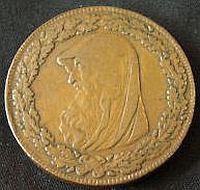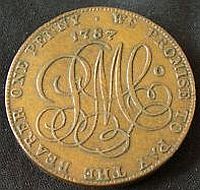|
Amman Valley Artifacts and Memorabilia Pary's Token PennyThe above item is a Pary's token penny which was commissioned by Thomas Williams for use by his Pary's Mine Company of Anglesey due to there being a shortage of small coinage at the time. The copper token penny bears the image of a druids head, circled with a wreath of what appears to be oak leaves. The reverse bears the letters PMCo and is circled by the following text: "We promise to pay the bearer One Penny". The above token is dated 1787 and would have been accepted in a variety of places which probably included parts of Swansea, one of the destinations for the company's copper ore. Pary's copper mine at Anglesey was at one time the largest in Europe. Pary's were not the only company who produced their own coinage at the time but it is believed that they were among the first. Between 1787 and 1792 it is estimated that over 300 tons of token coins were produced by Pary's own mint in Birmingham and other mints in London. An article written by D. Neville Patchett for the Amman Valley Historical Society tells how his father Edwin Patchett, as a young boy, found a Pary's Token Penny on the higher reaches of Grenig Road, Glanamman. The old drovers road connected Llandeilo and Llandyfan with Swansea and Neath via the Amman Valley. It is believed that the image of the Druids head was taken from a historical publication by Henry Rowlands titled "Mona Antiqua Restaurata", which focused on Anglesey, which of course was the last stronghold of the Celtic Druids. The tokens were re-collected in 1797 when the crown commissioned the issue of the first copper pennies (Cartwheel Penny). Pary's tokens were however still accepted in parts of North Wales until the early 19th Century. Information for this page was taken from the Wikipedia
Website and from "A Lucky find on the Betws Mountain", by
D. Neville Patchett for the Amman Valley Historical Society. |

